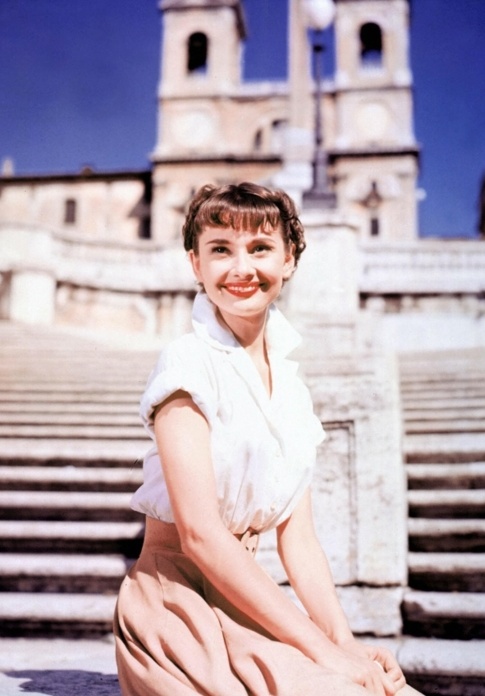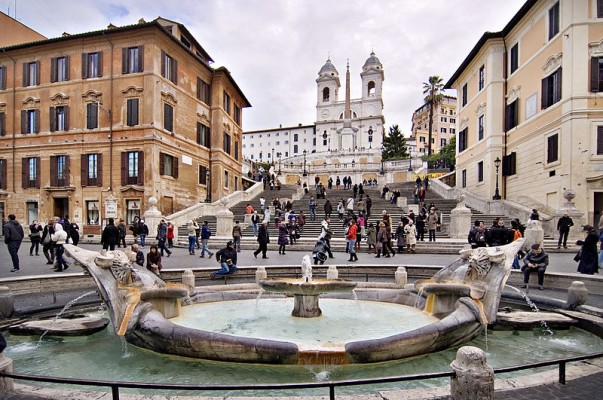 Piazza di Spagna in an 18th-century etching by Giovanni Battista Piranesi, seen from south. The street on the left is Via del Babuino, leading to Piazza del Popolo.
Piazza di Spagna in an 18th-century etching by Giovanni Battista Piranesi, seen from south. The street on the left is Via del Babuino, leading to Piazza del Popolo.
The Spanish Steps or Scalinata della Trinità dei Monti are a set of steps in Rome, Italy, climbing a steep slope between the Piazza di Spagna at the base and Piazza Trinità dei Monti, dominated by the Trinità dei Monti church at the top.
The monumental stairway of 135 steps (the slightly elevated drainage system is often mistaken for the first step) was built with French diplomat Étienne Gueffier’s bequeathed funds of 20,000 scudi, in 1723–1725, linking the Bourbon Spanish Embassy, and the Trinità dei Monti church that was under the patronage of the Bourbon kings of France, both located above — to the Holy See in Palazzo Monaldeschi located below. The stairway was designed by architects Francesco de Sanctis and Alessandro Specchi.
 In the piazza, at the corner on the right as one begins to climb the steps, is the house where English poet John Keats lived and died in 1821; it is now a museum dedicated to his memory, full of memorabilia of the English Romantic generation.
In the piazza, at the corner on the right as one begins to climb the steps, is the house where English poet John Keats lived and died in 1821; it is now a museum dedicated to his memory, full of memorabilia of the English Romantic generation.
At the top the stairway ramp up the Pincio which is the Pincian Hill. From the top of the steps the Villa Medici can be reached.
During Christmas time a 19th-century crib is displayed on the first landing of the staircase. During May, part of the steps are cover
ed by pots of azaleas. In modern times the Spanish Steps have included a small cut-flower market. The steps are not a place for eating lunch, being forbidden by Roman urban regulations, but they are usually crowded with people.
In the Piazza di Spagna at the base is the Early Baroque fountain called Fontana della Barcaccia (Fountain of the ugly Boat), built in 1627-29 and often credited to Pietro Bernini, father of a more famous son, Gian Lorenzo Bernini, who is recently said to have collaborated on the decoration. The elder Bernini had been the pope’s architect for the Acqua Vergine, since 1623. According to a legend, Pope Urban VIII had the fountain installed after he had been impressed by a boat brought here by a flood of the Tiber river.
 The film Roman Holiday (William Wyler, 1953), starring Audrey Hepburn and Gregory Peck, made the Spanish Steps famous to an American audience
The film Roman Holiday (William Wyler, 1953), starring Audrey Hepburn and Gregory Peck, made the Spanish Steps famous to an American audience
 The apartment that was the setting for The Roman Spring of Mrs. Stone (José Quintero, 1961) is halfway up on the right
The apartment that was the setting for The Roman Spring of Mrs. Stone (José Quintero, 1961) is halfway up on the right

 The Steps were featured prominently in the film version of The Talented Mr. Ripley(Anthony Minghella, 1999) starring Matt Damon in the title role
The Steps were featured prominently in the film version of The Talented Mr. Ripley(Anthony Minghella, 1999) starring Matt Damon in the title role
To watch Morten Harket’s Spanish Steps music video, please take a gander at The Genealogy of Style’s Facebook page: https://www.facebook.com/pages/The-Genealogy-of-Style/597542157001228?ref=hl














 Simone Signoret and Yves Montand relax in the bungalow of their Beverly Hills Hotel, where they were staying while he was filming Let’s make Love with Marilyn Monroe.
Simone Signoret and Yves Montand relax in the bungalow of their Beverly Hills Hotel, where they were staying while he was filming Let’s make Love with Marilyn Monroe.











